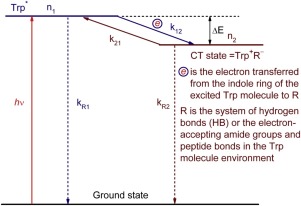Journal of Photochemistry and Photobiology A: Chemistry ( IF 4.3 ) Pub Date : 2020-02-14 , DOI: 10.1016/j.jphotochem.2020.112435 Peter P. Knox , Vladimir V. Gorokhov , Boris N. Korvatovsky , Nadezhda P. Grishanova , Sergey N. Goryachev , Vladimir Z. Paschenko

|
The temperature dependence of tryptophan fluorescence lifetime in an aqueous solution, aqueous solutions of glycerol (50 and 75 %, v/v) and dimethyl sulfoxide (DMSO) (50 and 75 %), and 1 M aqueous trehalose solution was studied in the range of –170 to +20 °C. In this temperature range, the fluorescence kinetics in all samples is best approximated by three exponential terms with characteristic times τ1 ∼ 3 ns, τ2 ∼ 4 ns, and τ3 ∼ 15 ns at room temperature. Temperature dependences of fluorescence lifetimes for the fastest and medium components exhibited antisymbatic (antiphase) behavior in the temperature range of –60 to 10 °C. To explain this behavior, a model was suggested that takes into account the tryptophan (Trp) molecule transition from the excited state to the state with separated charges – charge transfer state (CTS), the transitions back to the excited state, and the radiative transitions of the CTS to the ground state. Mathematically, this model is equivalent to the model that we have suggested earlier in [Gorokhov et al. (2018) Biochemistry (Moscow), 82, 1615–1623] to describe the transitions between different rotamer forms of tryptophan. The obtained results can be used for interpreting the experimental temperature curves of tryptophan fluorescence lifetime in proteins.
中文翻译:

色氨酸荧光寿命在−170–20°C的温度范围内的温度依赖性的特定特征
在此范围内,研究了水溶液,甘油(50%和75%,v / v)和二甲基亚砜(DMSO)(50%和75%)的水溶液以及1M海藻糖水溶液中色氨酸荧光寿命的温度依赖性。 –170至+20°C。在该温度范围内,在所有样品中的荧光动力学最好由具有特征时间τ3指数项近似1〜3纳秒,τ 2〜4纳秒,和τ 3在室温下约为15 ns。最快和中等成分的荧光寿命的温度依赖性在–60至10°C的温度范围内表现出反共(反相)行为。为了解释这种行为,提出了一个模型,该模型考虑了色氨酸(Trp)分子从激发态到具有分离电荷的态的转变-电荷转移态(CTS),转变回到激发态以及辐射转变将CTS移至基态。从数学上讲,该模型等效于我们先前在[Gorokhov等人,1986年提出的模型。(2018)生物化学(莫斯科),82(1615–1623)来描述色氨酸不同旋转异构体形式之间的过渡。所得结果可用于解释蛋白质中色氨酸荧光寿命的实验温度曲线。


























 京公网安备 11010802027423号
京公网安备 11010802027423号